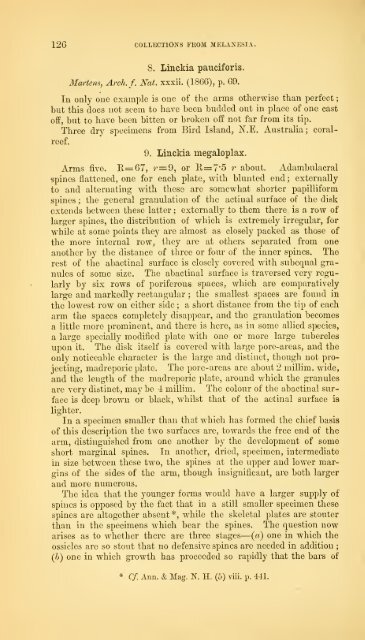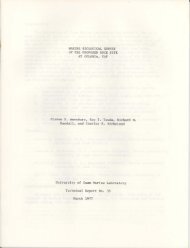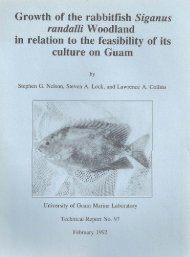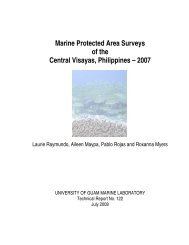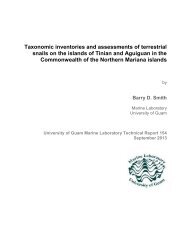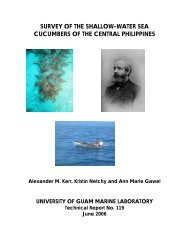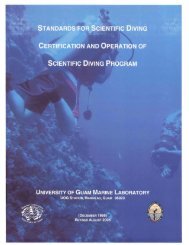You also want an ePaper? Increase the reach of your titles
YUMPU automatically turns print PDFs into web optimized ePapers that Google loves.
126 COLLECTIONS FROM MELANESIA.<br />
8. Linckia pauciforis.<br />
Martens, Arch.f. Nat. xxxii. (1866), p. 69.<br />
In only one example is one of the arms otherwise than perfect<br />
but this does not seem to have been budded out in place of one cast<br />
off, but to have been bitten or broken off not far from its tip.<br />
Three dry specimens from Bird Island, N.E. Australia; coral-<br />
reef.<br />
9. Linckia megaloplax.<br />
Arms five. R=67, r=9, or Il=7'5 r about. Adambulacral<br />
spines flattened, one for each plate, with blunted end ; externally<br />
to and alternating with these are somewhat shorter papilliform<br />
spines ; the general granulation of the actinal surface of the disk<br />
extends between these latter; externally to them there is a row of<br />
larger spines, the distribution of which is extremely irregular, for<br />
while at some points they are almost as closely packed as those of<br />
the more internal row, they are at others separated from one<br />
another by the distance of three or four of the inner spines. The<br />
rest of the abactinal siirface is closely covered with subequal granules<br />
of some size. The abactinal surface is traversed very regularly<br />
by six rows of poriferous spaces, which are comparatively<br />
large and markedly rectangular ; the smallest spaces are found in<br />
the lowest row on either side ; a short distance from the tip of each<br />
arm the spaces completely disappear, and the granulation becomes<br />
a little more prominent, and there is here, as in some allied species,<br />
a large specially modified plate with one or more large tubercles<br />
upon it. The disk itself is covered with large pore-areas, and the<br />
only noticeable character is the large and distinct, though not projecting,<br />
madrcporic plate. The pore-areas are about 2 milhm. wide,<br />
and the length of the madreporic plate, around which the granules<br />
are very distinct, may be -1 millim. The colour of the abactinal sur-<br />
face is deep brown or black, whilst that of the actinal surface is<br />
lighter.<br />
In a specimen smaller than that which has formed the chief basis<br />
of this description the two surfaces arc, towards the free end of the<br />
arm, distinguished from one another by the development of some<br />
short marginal spines. In another, dried, specimen, intermediate<br />
in size between these two, the spines at the upper and lower margins<br />
of the sides of the arm, though insignificant, are both larger<br />
and more numerous.<br />
The idea that the younger forms would have a larger supply of<br />
spines is opposed by the fact that in a still smaller specimen these<br />
spines are altogether absent *, while the skeletal plates are stouter<br />
than in the specimens which bear the spines. The question now<br />
arises as to whether there are three stages— («) one in which the<br />
ossicles are so stout that no defensive spines are needed in addition<br />
(h) one in which growth has proceeded so rapidly that the bars of<br />
* Cf. Ann. & Mag. N. H. (5) viii. p. 441.<br />
;


